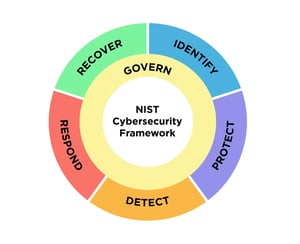 The NIST Cybersecurity Framework was updated last week. This is the first major update to the framework since it was first introduced in 2014. The framework has helped organizations by providing them with guidance on understanding, evaluating, and communicating cybersecurity risks.
The NIST Cybersecurity Framework was updated last week. This is the first major update to the framework since it was first introduced in 2014. The framework has helped organizations by providing them with guidance on understanding, evaluating, and communicating cybersecurity risks.
With the new version of the NIST Framework, the following are some of the most important changes that have been made.
- The NIST cybersecurity framework (CSF) now explicitly aims to help organizations manage and reduce risks across a broad range of sectors, not just critical infrastructure. The expansion of the target audience for the NIST Cybersecurity Framework is due to the increasing importance of cybersecurity across all sectors. With the rise in cyber attacks and the increasing reliance on technology, all organizations need to have a framework for managing and reducing cybersecurity risks. By extending the framework's reach, more organizations can benefit from the guidance and best practices outlined in the updated version.
- The Introduction of a “Governance” function. In Version 1.1, there were 5 functions: Identify, Protect, Detect, Respond, and Recover. With the addition of the 6th category, Govern, the NIST CSF underscores the important role of governance in cybersecurity risk management. Transparency and accountability unite the goals outlined in the other five functions, helping organizations achieve their goals. It highlights that cybersecurity is not a standalone concern but an important part of enterprise risk.
- The NIST CSF 2.0 includes Quick Start guides, reference tools, and organizational and community profile guides. In comparison to Version 1.1, these reference tools will simplify the implementation of the CSF for organizations. The Quick Start guides and reference tools included in the updated version of the NIST Cybersecurity Framework (CSF) provide organizations with a simplified and streamlined approach to implementing the framework. These resources offer clear instructions and guidance, helping organizations to quickly understand and apply the concepts and practices of the CSF. By providing these resources, NIST wants to make it more accessible and user-friendly for organizations to enhance their cybersecurity risk management and mitigation strategies.
- Organizational profiles to help organizations determine their current cybersecurity status. This will also help organizations determine what cybersecurity status they would like to work towards as well as provide them with a path to achieving that goal. As a result, NIST believes that having multiple profiles - both current and goal - will allow organizations to identify weak spots in their cybersecurity implementations and help them achieve higher levels of security.
We believe these changes will help organizations better get a handle on their cybersecurity. You can rely on Quick Intelligence to assist your organization in several ways: helping you understand how ready your organization is to follow the NIST CSF by conducting a readiness assessment, helping you build out a strategy and roadmap to implement the NIST CSF, and providing tools that will help you visualize where you’re at in your journey towards implementing the framework, along with guidance and action items to help you track your progress. Get in touch with us!
